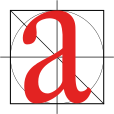Glyph
From Wikipedia, the free encyclopedia
A glyph (pronounced /glɪf/) is an element of writing. Two or more glyphs representing the same symbol, whether interchangeable or context-dependent, are called allographs; the abstract unit they are variants of is called a grapheme or character. Glyphs may also be ligatures, that is, compound characters, or diacritics.
Contents |
[edit] Etymology
The term has been used in English since 1727, borrowed from glyphe in use by French antiquaries (since 1701), from the Greek γλυφή, glyphē, "carving," from the verb γλύφειν, glýphein, "to hollow out, engrave, carve" (cognate to Latin glubere "to peel" and English cleave).
Compare the carved and incised "sacred glyphs" hieroglyphs, which have had a longer history in English dating from the first Elizabethan translation of Plutarch, who adopted "hieroglyphic" as a Latin adjective.
But "glyph" first came to widespread European attention with the engravings and in lithographs from Frederick Catherwood's drawings of undeciphered glyphs of the Maya civilization in the early 1840s.
[edit] Archaeology
In archaeology, a glyph is a carved or inscribed symbol. It may be a pictogram or ideogram, or part of a writing system such as a syllable or logogram.
[edit] Typography

In typography, a glyph is a particular graphical representation, in a particular typeface, of a grapheme, or sometimes several graphemes in combination (a composed glyph), or a part of a grapheme. In computing as well as typography, the term character refers to a grapheme or grapheme-like unit of text, as found in natural language writing systems (scripts). It may be a letter, a numeral, a punctuation mark, or a pictographic or decorative symbol such as dingbats. A character or grapheme is an abstract unit of text, whereas a glyph is a graphical unit.
For example, the sequence ffi contains three characters, but can be represented by one glyph, the three characters being combined into a single unit known as a ligature. Conversely, some typewriters require the use of multiple glyphs to depict a single character (for example, two hyphens in place of an em-dash, or an overstruck apostrophe and period in place of an exclamation mark).
Most typographic glyphs originate from the characters of a typeface. In a typeface each character typically corresponds to a single glyph, but there are exceptions, such as a font used for a language with a large alphabet or complex writing system, where one character may correspond to several glyphs, or several characters to one glyph.
[edit] Graphonomics
In graphonomics, the term glyph is used for a non-character, i.e: either a sub-character or multi-character pattern.
[edit] Other uses
- In the mobile text input technologies, Glyph is a family of text input methods based on the decomposition of letters into basic shapes.
[edit] See also
|
|||||||||||||||||||||||||||||||




